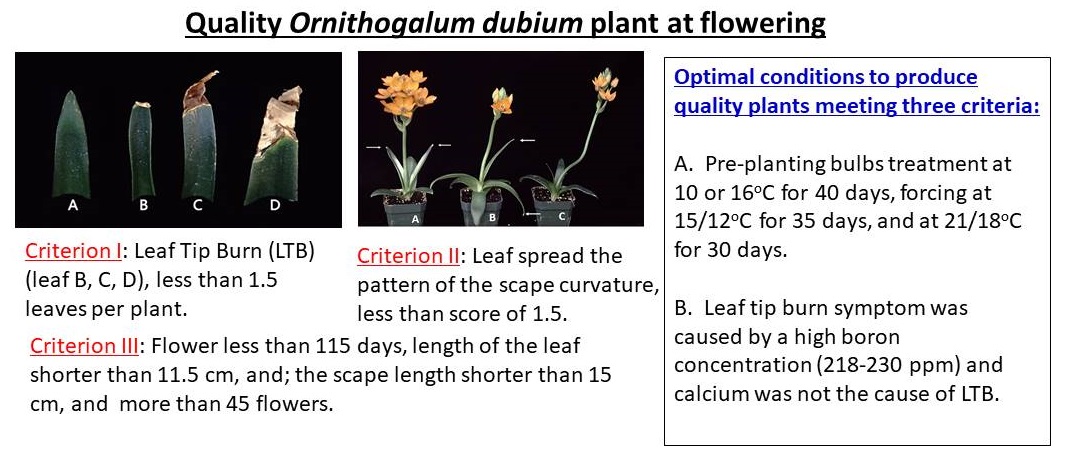Reduction of leaf tip burns of Ornithogalum dubium by controlling the temperature during bulb storage and greenhouse forcing to produce quality plants

Published 2022-01-14
Keywords
- Boron toxicity,
- controlled flowering,
- leaf morphology,
- optimum temperature,
- quality criteria
- scape growth ...More
How to Cite
Abstract
Production of quality potted Ornithogalum dubium Houtt. plants were investigated under multiple conditions: pre-planting treatment at 10, 16, and 22°C for 40 days from Sept. 21 (stage A; ST-A) during bulb storage and then bulbs were potted. After potting, post-planting treatment at 15/12, 18/15, and 21/18°C (day/night) during stage B for 35 days from Nov. 2 (stage B; ST-B), and at 15/12 and 21/18°C during stage C for 30 days from Dec. 7 (stage C; ST-C) during greenhouse forcing was applied. Leaf tissue analyses for macro- and micro-nutrients were performed to investigate the cause of leaf tip burn symptom (LTB). Three criteria for quality of the plants at flowering were established: (1) LTB occurs on less than 1.5 leaves per plant. (2) the number of days to flower is less than 115 days, the length of the third leaf counted from the crown (the junction of the shoot and roots) is shorter than 11.5 cm, and the width is narrower than 2.5 cm; the scape length is shorter than 15 cm, and there are more than 45 flowers. (3) the leaf spread and morphology (leaf spread) and the pattern of the scape curvature (scape growth) have a score of less than 1.5. The following conditions are optimal to produce quality plants based on these three criteria: (1) Pre-planting bulbs treatment was applied at 10 or 16°C during ST-A, and forcing was performed at 15/12°C during ST-B and 21/18°C during ST-C. These conditions accelerated flowering, produced straight scape growth and upward (erect) growing leaves, and yielded acceptable leaf length and width. (2) The incidence of LTB was minimal at 10°C or possibly 16°C during ST-A, and at 15/12°C in ST-B and at 21/18°C in ST-C during greenhouse forcing. Leaf tip burn symptom was observed in both young and old leaves and was caused by a high boron (B) concentration (218-230 ppm) and possibly a high zinc (Zn) concentration (155-159 ppm) in O. dubium. A low calcium (Ca) concentration was not the cause of LTB. Although LTB cannot be avoided, it can be minimized by temperature manipulation during pre- and post-planting phase to produce high quality potted plants.





